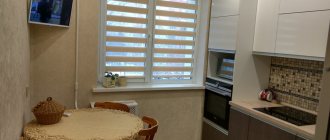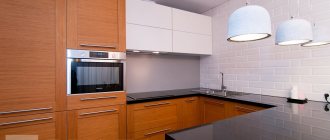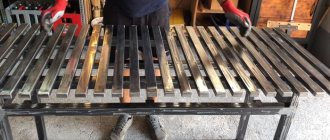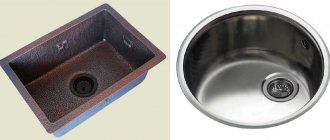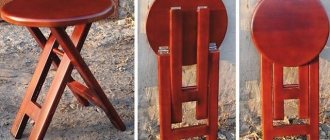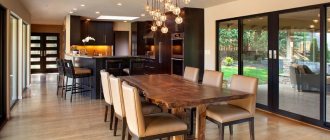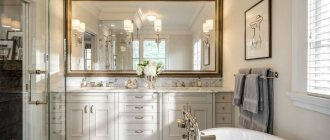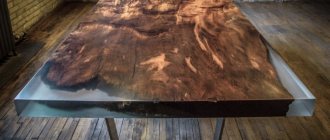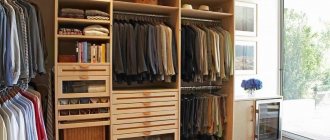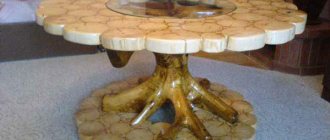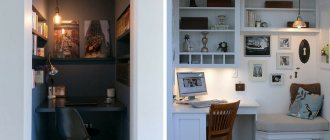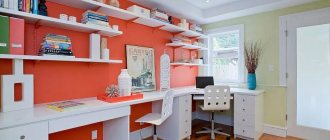Natural wood fits harmoniously into almost any interior. A tabletop made of a high-quality processed solid piece looks original and stylish, creating a cozy atmosphere in the room. The material is warm, pleasant to the touch, and has a beneficial effect on the psychological state of people.
However, it is not easy to buy a ready-made countertop made of natural wood. There are few of them, the prices for such products are very high, and the quality of the wood may not be the best. Especially when it comes to a tabletop made from cut wood, which requires high-quality preparation and processing. It is much cheaper to make such a product yourself. Let's look at the features and methods of making a table from cut wood with your own hands.
Features of tabletops made from cut wood
An ordinary tabletop made of natural wood is a wood panel glued together from several boards. It has the correct geometric shape, the edges are processed with a shaped cutter or, at a minimum, are polished with high quality.
Expert opinion
Korzhavin Daniil Dmitrievich
Designer of stylish home furniture
A saw-cut tabletop is a solid piece of a tree trunk, which is a cut made perpendicular or oblique to the longitudinal axis. The thickness of the cut is chosen based on the shape and characteristics of the existing piece of wood. As a rule, the edges of the cut are not shaped in any way, leaving the natural contours of the tree trunk as nature created them.
There are different cutting options:
. This cut produces a plate, the size of which is determined by the diameter of the trunk. The stresses in the massif are distributed approximately equally in all areas, which avoids deformation during drying;
perpendicular to the longitudinal axis- at an angle to the longitudinal axis . This cut allows you to obtain a plate of a larger area, the shape of which is close to an oval. Shrinkage stresses are located unevenly, which requires high-quality preparation and conditioning of the trunk before sawing;
- along the longitudinal axis . This cut allows you to obtain a layer of maximum size. Its width is limited by the diameter of the trunk, and its length is determined by the size of the log. Loads during shrinkage are located according to the direction of the annual rings, which often causes the board to bend into a tube.
The first and second cutting options are most often used. The first is chosen if there is a workpiece (log) of large diameter. Such a cut is economical; here only the thickness of the cut and the allowance for grinding are wasted.
An inclined cut gives an expressive and unique pattern of annual rings. However, this cutting method is the most uneconomical - the remaining parts of the trunk have a small area and cannot be used for any large-sized products.
A longitudinal cut gives a regular board of the required thickness. Sometimes the trunk is cut exactly in the middle and two halves are obtained, of which only the flat sides are processed. This option allows you to get two tabletops with a pattern that is repeated in a mirror image.
Expert opinion
Korzhavin Daniil Dmitrievich
Designer of stylish home furniture
There are other options for assembling a tabletop, in which they use cuts not from one trunk, but from a large number of thick branches (or thin trunks). As a rule, many cuts are laid and the spaces between them are filled with epoxy resin (or other hardening high-strength polymer).
This method allows you to get a tabletop of any size, but does not provide the attractiveness that a solid piece of wood has. Sometimes, instead of pouring, a large piece of glass (or monolithic polycarbonate) is used, which is installed on top of a set of saw cuts.
What is the value of furniture made from branches, driftwood and stumps?
First of all, of course, uniqueness. No one in the world has the same furniture, since natural exclusivity is used - there are no identical branches, just as there are no identical fingerprints.
Decorative candlestick made of planks
Beneficial features:
- Safety. The material does not cause allergies, it does not contain toxins and other delights that factory products are full of.
- Reliability, especially if roots were used. With high-quality assembly, furniture lasts for decades.
- You can assemble any piece of furniture, since the material used is different (in shape and size).
There are no disadvantages, although insects may live inside the raw material, which must be exterminated, otherwise they will crawl out during the heating season.
Table legs
The design of the legs is usually chosen based on the characteristics of the tabletop, as well as your own capabilities. Sometimes a full-fledged tsar belt with conventional supports is made. Many users make legs from thick branches from which the bark has been removed. On the reverse side, blind holes of the appropriate diameter are made into which the ends of the branches are glued. All that remains is to adjust their length so that the table stands tightly and does not wobble.
There is an interesting option using combined materials. The table legs are forged supports, which in themselves have high decorative qualities. The overall appearance of such a table is very attractive; the product looks elegant and rich.
Methods of dissolution
A template wooden cut does not exceed a thickness of 5 cm. The standard scheme for dissolving slabs is that when dissolving the core remains 10 to 12 cm thick.
This is a necessary measure because stress in the barrel leads to the formation of cracks. But the production of wooden cuts 12 cm thick does not guarantee that the output slab will be intact.
- To form a wide blank, you need to glue two cuts.
- Creating glued forms goes against the principles of creating solid slabs, but such actions make it possible to create a workpiece with certain parameters.
- The technology helps reduce stress in the barrel, thereby increasing the quality and service life of the product.
How to choose material
The easiest way is to purchase a ready-made saw cut and look for suitable options in online stores. However, for many users it is more interesting to choose the material themselves and make a plate from a log.
To make a tabletop, you need a plate of the largest possible size. It can be obtained from large diameter logs, at least 500 mm (ideally more than 600 mm).
Coniferous trees predominate on the territory of our country. They have pronounced annual rings, straight-grained wood with a large amount of resin. It is the resin that can become an undesirable point, since it has poor contact with paint and varnish coatings. It is noteworthy that most conifers have a similar texture and are easy to confuse.
Hardwoods have a wide variety of textures. There are rocks with pronounced annual rings and a large number of pores. These are ash, acacia, chestnut. There are species with homogeneous and inexpressive wood - birch, maple. However, it is these rocks that have significant undulation in the lower part of the trunk. Therefore, it is recommended to cut them along the longitudinal axis.
It is difficult for an inexperienced person to determine by the type of log what it will look like when cut. This is a task that is not available to every professional - a tree trunk is a living organism, and its condition is extremely difficult to predict.
However, you can adhere to the basic rules:
- You should not choose a rotten log. You can knock on its side - if the sound is dull and “raw”, it’s better to look again;
- an uneven and knobby trunk in this case will only be an advantage, since its cut looks more attractive;
- the closer to the root the cut is located, the more interesting its texture will be;
- cracks or other imperfections, if not too many, can only decorate the tabletop (although they will have to be completely filled with epoxy resin or polyester putty).
Most often there is not much choice. There are few large trunks, since they are brought only to order. Therefore, you have to be guided by the main condition - size. If the size of the cut is suitable for solving the tasks, flaws can be corrected or hidden.
Transportation of lumber
To transport timber you will need large loading equipment. In particular, this is necessary for transporting entire trunks. If you intend to transport small pieces of wood, then large equipment is not required; it is possible to carry out the loading yourself.
You will need a cable, trailer and ramps. It is necessary to monitor the balance and measured distribution of the weight of the barrel. To secure the slab you will need strong straps.
Making saw cuts
As a rule, the cut is made using an electric or chainsaw.
It is necessary to mark the cutting line by tracing the log in a circle (or along the oval line if the cut is inclined). When making a cut, you should try to maintain a plane to reduce the amount of grinding. Some craftsmen make special devices that make the work easier and help ensure the most even plane. However, if you need to make just one plate, you can do without additional devices - the time spent on their manufacture can be used for processing the cut.
Expert opinion
Korzhavin Daniil Dmitrievich
Designer of stylish home furniture
The task is quite complex and responsible. If you do not have experience and skills in such work, it is better to contact a specialist and ask him to make a cut according to pre-made markings. This will not take much time, but will significantly speed up the processing of the saw cut.
Decoration of any interior
Many horizontal rounded cuts of wood are now actively used as decoration for walls, floors and, of course, in the production of tables, chairs, and other furniture. Tables finished using this technique are unique; the arrangement of small and large cut circles can be arbitrary or form a specific pattern.
Making a beautiful product with your own hands is not easy, but very interesting. And if you follow all the requirements for the work, the result will please you.
Leveling the plane
The cut that has just been made usually has to be prepared for grinding. You can immediately take up the grinder only in particularly successful cases, when the cut turns out to be very even.
First, the surface must be planed using a manual or electric plane. It is important to keep in mind that the blade of a hand plane must be prepared for such work and fine teeth must be applied to it. Otherwise, it will stick, especially when passing against the direction of the fibers. An electric planer is much more effective in this regard. You just need to adjust the reach of the blade so as not to remove too thick chips and not reduce the thickness of the sawn block.
Planing is completed when a sufficiently flat plane is obtained. It is checked with a ruler or a straight strip applied to the plane of the block in several places and directions. After this you can start sanding.
Grind the cut using a grinder or a special attachment on an electric drill. First, the plane is inspected and checked for cracks, potholes or other flaws. If there are any, it is recommended to fill with epoxy resin or polyester putty. When the material hardens, begin processing the plane.
Using successively sandpaper with coarse, then finer grains, a smooth cut surface is obtained. The quality of sanding depends on the skills of the craftsman and the type of wood - some of them can be practically polished, others can only be leveled as much as possible.
Expert opinion
Korzhavin Daniil Dmitrievich
Designer of stylish home furniture
As a rule, change 2 or 3 sizes of sandpaper. This is enough, since wood is not metal, too small marks on its surface are almost impossible to see.
The principle of choosing wood for a slab
Not every type of wood is suitable for creating slabs yourself. The following types of wood are best suited:
- Elm is an excellent material for creating slabs. Can be used in both dry and wet rooms.
- Oak slabs amaze with their excellent color palette: from light brown to straw-yellow shades. Thanks to its straight grain, oak wood is much easier to work with than other types of wood.
- In the color scheme of elm, light shades with red-brown specks are more common than others. Fine-pored texture is a distinctive feature of wood.
- The color palette of larch depends on the age of the tree. Sand and amber are the leading shades. Easy to use thanks to the high concentration of essential oils.
- Walnut wood has a wide range of colors. Dark chocolate shades are in the lead. A significant disadvantage is that the texture is susceptible to cracks.
- Maple saw cuts in beige shades. The colors are practically independent of the age of the tree.
- Cherry cuts are distinguished by chocolate and soft pink shades. Suitable for creating decorative elements.
Varnishing, polishing
When sanding is completed, the surface is thoroughly cleaned of dust and finishing begins. First, apply a layer of deep penetration primer. This allows the top layer of wood to be compacted and improves the adhesion of the final varnish layer to the surface.
Would you make your own countertop from a cut piece of wood?
Of course! It's better to buy
Please note that primer is not needed for all types of wood. Basically, it is used to reduce the consumption of more expensive varnish. At the same time, the varnish is often absorbed much deeper, which helps to fix and compact the material. Therefore, only highly porous workpieces need to be primed.
If coniferous wood is used, the resin escape routes must be closed. To do this, the material is thoroughly wiped with turpentine and solvent (645, 646, 647). After this, you need to apply a varnish that does not react to the presence of resin. It is recommended to use nitrocellulose compounds, since other varnishes may dissolve upon contact with the resin.
If there is a lot of resin, you can heat the top plane - this will cause abundant resin. The workpiece will have to be heated for quite a long time until the bulk of the resin is removed. However, it is unlikely that it will be possible to completely get rid of it; additional measures will have to be used (resin removal and coating with neutral grades of varnish).
Varnishing can be done using a spray gun, or using a regular paint brush. The number of layers depends on what further actions are planned with the countertop. If polishing is carried out, you need to apply a couple of extra layers - they will go away when polishing the surface. It is necessary to keep in mind that after each layer you need to wait for the varnish to dry completely, usually for a day (there may be other options, it depends on the type of varnish).
Polishing the varnish is done in several stages:
careful sanding with fine sandpaper. First they use coarser grains, then move to almost zero grains. The entire process requires the use of 2 or 3 numbers of skins. Grind only by hand, wrap the sandpaper on a smooth wooden block and do not apply too much force;- When the surface is brought to the smoothest possible state, take the foam rubber attachment to an electric drill and polish the varnish. Use 3M automotive polishing paste;
- first polish with the first number, then with the second. There is no point in using the third number at home - its effect is rarely noticeable.
Expert opinion
Korzhavin Daniil Dmitrievich
Designer of stylish home furniture
The polishing procedure is quite complicated and requires a lot of time and effort. However, if you try, you can get a very high-quality coating that corresponds to group A.
Where to get raw materials
You can find natural material in the forest, on the shore, in your own garden after pruning trees, or pulled out of the water. Depending on the location of detection, the pre-treatment of raw materials varies. Anything found on land is sanded, cleaned of rotten fragments, and rotten layers are removed down to the hard wood. What is taken out of the water is cleaned of contaminants and dried.
The jackpot is considered to be the discovery of bog oak. Furniture made from it is considered elite, and dark wood is recognized as the most durable. However, other tree species are quite resistant.
Questions and answers
Making a table from sawn wood is a largely creative process. The search for the right techniques often leads novice masters to a dead end. A large number of questions arise, some of them should be answered immediately. This will save time, and may give someone useful ideas.
Can I use epoxy to level the surface without sanding?
You can, but you will have to be more careful with the table surface. Any load can lead to cracking of the coating and cause peeling of the epoxy. In such cases, it is recommended to use an additional transparent element - for example, glass.
What types of wood are best suited for making a saw-cut table?
Here we can recommend such species as oak, walnut, ash or more exotic ones - mahogany, rosewood, paduk. However, they are extremely difficult to find in log form - they are usually supplied as lumber. You can look for thick birch stumps, or use a cut of maple or alder.
Is it possible to stain wood?
This procedure is done very often. However, you need to choose the right material. It is recommended to use an alcohol-based stain, or even better, a regular water-based stain. It is applied before pouring epoxy or primer. This is an important point, since after this the stain will not be absorbed into some areas of the countertop, and unsightly stains will appear.
What varnish is best to use for finishing?
It is necessary to take into account that the tabletop experiences significant operational loads. Therefore, you will need the hardest varnish. Automotive acrylic products should not be used - they resemble hard rubber. Furniture nitro varnish (for example, domestic NTs218) is best suited. However, it is best to use polyurethane varnishes for parquet. You can buy Rustins clear Varnish. It dries quickly and is highly durable. It will take longer to polish, but the quality of the coating will be very high.
Is it necessary to polish the varnish?
No, you can simply cover the surface with a neat thin layer. You can do without it altogether by using linseed or any special oil (for example, Danish Oil for treating gun stocks). This impregnation does not form a surface layer, but makes the wood brighter and more attractive.
Pleasant trifles
A stylish frame of small branches will radically transform a familiar attribute of your home decor:
- vase;
- watch;
- photo frame;
- mirror;
- candelabra;
- shade.
In the last two options, it is worth considering fire safety rules.
Tools
The materials you need to stock up on are logs and, if necessary, stain. The tools you need to acquire are:
- saw and hacksaw;
- drill with large drill bits;
- plane;
- screws and nails;
- “Moment” glue for wood and metal;
- hammer;
- a piece of leveled reinforcement;
- sandpaper.
Assembly Rules
Processing the ends involves observing nuances. Processing is carried out using a coarse brush. Cleaning is done using a drill. You need to act clockwise. You shouldn't push! Then the treatment is carried out with a fine brush. Next, the roots are dried and assembly begins.
Methods of joining furniture parts can be different - gluing, clinching, mounting with screws. When choosing a mount for a wood grouse screw, you can put a decorative cap on top. The joints are treated with special glue.
The seat can be made from several roots. You can fasten them with hemp rope. The method will make the furniture durable and individual.
You can also learn how to make furniture from belts.
Create a drawing
Before you begin installing the table, you need to make a drawing on a sheet of paper. Here the dimensions of the structure are plotted and a log layout diagram is selected. You can make a drawing on paper in several projections.
A three-dimensional drawing made in computer programs is considered more convenient. You can examine a piece of furniture from all sides, select dimensions, and also determine how a particular type of wood will look. The table, which is designed with a special program, can be adjusted to suit the specific interior of the room.
A simple “wild” bench without a single nail
How to make a bench is already clear. To get a bench, you only need to attach the backrest. It can be attached without a single nail, screw, etc.
To do this, take two bars of triangular or trapezoidal cross-section. We get it from one, sawing it in the middle. A triangular section is needed to make a dovetail connection between the bars and the seat and backrest.
Dovetail connection: trapezoidal tenon into trapezoidal groove.
In the half-logs for the seat and back, triangular (trapezoidal) grooves for supports are cut out so that the wide part is inside the half-logs. Then all the elements are connected in these grooves. In the video you will see that it is easier than it sounds in words:
But this is more difficult than it looks. The main difficulty is to cut grooves of the desired shape at the desired angle in the rounded surface of the half-logs. Without certain dexterity and experience in working with a chainsaw, this is not easy.
There is a simpler option - do without the dovetail, use self-tapping screws or nails to attach the backrest supports to the bench. The supports are attached to chocks, which serve as legs; they can also be attached additionally to the seat mass. The back can be secured in the same way by cutting out moon grooves in the supports themselves, if they are thick enough. We get approximately the following:
Simple and stylish - a bench made of logs.
To make the benches and benches described above, you need initial logs from approximately 35 cm in diameter (if we take the same ones). This is dictated by the comfortable parameters of the bench or bench itself. Its height is 40-50 cm. The height of the seat plane is about 1.5 times the diameter of the log. The final calculation depends on the depth of the groove, but it is not necessary to cut it deep.
Another important note:
For two benches, it is advisable to cut the log in half, but for a bench, it is better to move the cutting plane away from the diameter plane, so that the beam for the back is smaller than for the seat. Firstly, your bench will be 5-10 cm higher, which is important if the log is not thick enough. Secondly, do not forget about the center of gravity of the bench.
If the half-log for the back is as massive as the seat, and the back is sloped, then the structure may be unstable. This problem can be solved if you rigidly attach the seat to the lower supports, but you will also be sitting on this bench! And you'll want to sit back!
To prevent the center of gravity from shifting so that the bench will tip over or wobble, the top of the backrest should not extend beyond the vertical axis passing through the extreme points of the lower supports and legs. It is better if the legs protrude further than the back of the bench.
The relative position of the extreme points of the rear legs and the back of the bench
Another significant parameter. There are various original design benches, chairs, etc., but for a standard bench or chair, the backrest slope is within 30° from the vertical axis.
Scheme for work
To take into account all the little things, you need to think through the drawing before work. Each size must be marked on it. If you are going to align the boards on only one side, then the diagram must be made in three dimensions.
If you will not process the boards, then a two-dimensional drawing will suffice. As a result, all parts of the table with their actual size should be drawn on the diagram.
